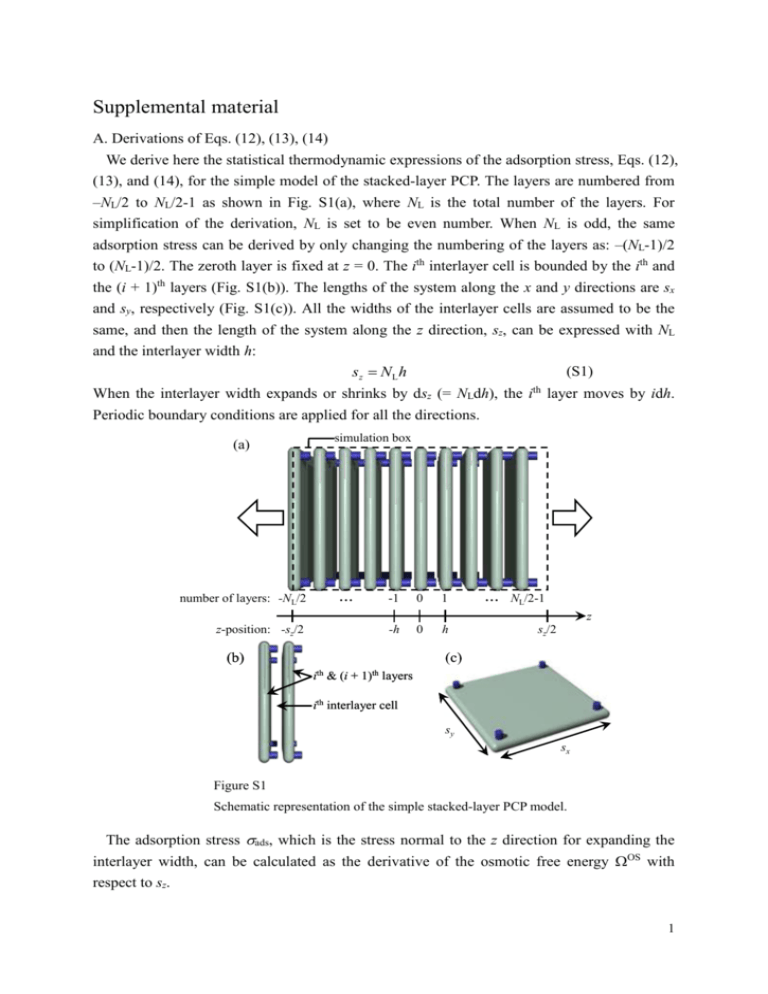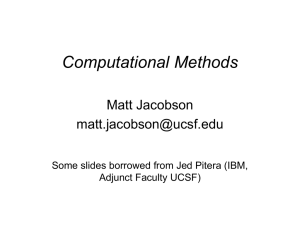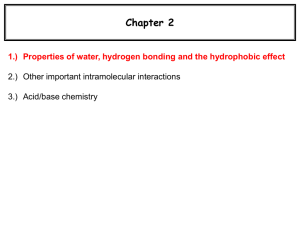Rev_SupplementalMaterial
advertisement

Supplemental material A. Derivations of Eqs. (12), (13), (14) We derive here the statistical thermodynamic expressions of the adsorption stress, Eqs. (12), (13), and (14), for the simple model of the stacked-layer PCP. The layers are numbered from –NL/2 to NL/2-1 as shown in Fig. S1(a), where NL is the total number of the layers. For simplification of the derivation, NL is set to be even number. When NL is odd, the same adsorption stress can be derived by only changing the numbering of the layers as: –(NL-1)/2 to (NL-1)/2. The zeroth layer is fixed at z = 0. The ith interlayer cell is bounded by the ith and the (i + 1)th layers (Fig. S1(b)). The lengths of the system along the x and y directions are sx and sy, respectively (Fig. S1(c)). All the widths of the interlayer cells are assumed to be the same, and then the length of the system along the z direction, sz, can be expressed with NL and the interlayer width h: (S1) sz N L h When the interlayer width expands or shrinks by dsz (= NLdh), the ith layer moves by idh. Periodic boundary conditions are applied for all the directions. (a) number of layers: -NL/2 simulation box -1 0 1 -h 0 h NL/2-1 z z-position: -sz/2 (b) sz/2 (c) ith & (i + 1)th layers ith interlayer cell sy sx Figure S1 Schematic representation of the simple stacked-layer PCP model. The adsorption stress ads, which is the stress normal to the z direction for expanding the interlayer width, can be calculated as the derivative of the osmotic free energy OS with respect to sz. 1 ads ( s z ) 1 Ω OS , A s z T , , A (S2) where A, T, and are the surface area of the layer (= sxsy), the temperature, and the chemical potential of the guest, respectively. The osmotic free energy is defined as the sum of the grand potential of the guest, , the Helmholtz free energy of the host, Fhost, and the PV-term Ω OS Ω F host PV , (S3) where P is the bulk gas pressure, and V is the system volume (= Asz). Thus, the adsorption stress can be calculated as ads ( s z ) 1 Ω 1 F host P. A s z T , , A A s z T , , A (S4) The first term on the right-hand side is the internal stress, int, applied by the guest particles, and the second term is identical to the force, Fzss, which works between the layers: 1 F host 1 U ss F ss z , A sz T , , A A sz T , , A A (S5) where Uss is the layer-layer interaction potential. Namely, the adsorption stress can be expressed as Fzss (S6) ads ( s z ) int P. A In what follows, we derive the internal stress, int. First, the grand potential of the guest particle can be calculated from the grand partition function : Ω kBT ln Ξ , (S7) where kB is Boltzmann constant. Then, is represented as N 3 Ξ T , , sz , A exp Z N T , N , sz , A , N 0 kBT N! (S8) where N is the number of guest particles, is the thermal de Broglie wavelength, and ZN is the configurational part of the canonical partition function. By using Eqs. (S7) and (S8), int can be expressed as 1 A sz T , , A int kBT 1 Ξ A Ξ sz T , , A kT 1 B A Ξ N Z N 3 exp N 0 N! kBT sz (S9) . T , , A 2 The partial derivative of ZN is given by Z N dr N exp U (r N ) sz s z sy / 2 sz / 2 N sx / 2 dxi dyi dzi exp U (r N ) , sy / 2 sz / 2 s z i 1 s x / 2 (S10) where U is the total potential energy of the guest particles, = 1/kBT, rN represents 3N-dimensional configuration of the guest particles, and xi, yi, and zi denote the configuration of the ith particle. Applying Leibniz’s rule to Eq. (S10), we obtain N sx / 2 sy / 2 sz / 2 Z N exp U dxi dyi dzi s / 2 s / 2 s / 2 x y z sz sz i 1 U dxi dyi dzi exp U . sx / 2 sy / 2 sz / 2 sz i 1 N sx / 2 sy / 2 (S11) sz / 2 Thus, Z N U dr N exp U . s z s z (S12) By substituting Eq. (S12) into Eq. (S9), we have int kBT 1 A Ξ N 3 U dr N exp exp U sz N 0 N! kBT 1 U A sz 1 U ff 1 U fs , A sz A sz (S13) where Uff and Ufs are the fluid-fluid and the fluid-solid interaction potential energies. Equation (S13) indicates that the internal stress can be obtained as the sum of the derivatives of the potential energies. The first term on the right-hand side of Eq. (S13) can be expressed as U ff s z ff 1 N L / 21 N k N L / 21 N m rij u (rij ) , 2 k N L / 2 i 1 m N L / 2 j 1 s z rij (S14) where Nk and Nm indicate the numbers of the particles in the kth and the mth interlayer cells, rij is the distance between the ith particle in the kth interlayer cell and the jth particle in the mth interlayer cell, uff is the fluid-fluid interaction potential for a pair of the guest particles. The distance rij can be calculated as rij xij yij (zki kh) (z mj mh) , 2 2 2 (S15) 3 where xij and yij are the x and y components of rij, and zki is the distance between the kth layer and the ith particle. Because the interlayer width h only depends on sz in Eq. (S15), we have rij s z zij k m . rij N L (S16) Substituting Eq. (S16) into Eq. (S14), we obtain U ff sz ff 1 N L / 2 1 N k N L / 2 1 N m zij k m u (rij ) . 2 k N L / 2 i 1 m N L / 2 j 1 rij N L rij (S17) Eq. (S17) indicates that the interaction between the guest particles in the different cells (i.e., k ≠ m) only contributes to the adsorption stress. Here, all the fluid cells are statistically identical because all the interlayer widths are set to be the same. Thus, the total fluid-fluid interaction Uff can be obtained by multiplying the interactions between the particles in the interlayer cell of m = 0 and those in the other cells (-NL/2 ≤ k ≤ NL/2-1), with the number of the interlayer cells, NL, to obtain U ff sz NL 2 ff k u (rij ) N r k N L / 2 i 1 j 1 rij L ij N L / 2 1 N k N 0 zij zij k u ff (rij ) Fzff , r 2 r k N L / 2 i 1 j 1 ij ij N L / 2 1 N k N 0 (S18) where N0 indicates the number of the particles in the zeroth cell. This is the molecular expression of the derivative of Uff. Then, the derivative of Ufs is given by U fs s z N L / 2 1 N m N L / 2 1 zik u fs ( zik ) , zik m N L / 2 i 1 k N L / 2 s z (S19) where zik is the distance between the ith particle in the mth interlayer cell and the kth layer, and ufs is the fluid-solid interaction potential of a guest particle. The derivative of zik is written as zik kh (zim mh) k m . (S20) s z N L h NL By substituting Eq. (S20) into Eq. (S19), we obtain U fs s z N L / 2 1 N m k m u fs ( zik ) . zik m N L / 2 i 1 k N L / 2 N L NL / 2 (S21) In a manner similar to Eq. (S17), Eq. (S21) can be rewritten as N0 Nl / 21 U fs k u fs ( zik ) NL sz zik i 1 k N L / 2 N L N L / 21 u fs ( zik ) k Fzfs . zik i 1 k N L / 2 N0 (S22) 4 By substituting Eqs. (S13), (S18), and (S22) into Eq. (S6), the “force” expression of the adsorption stress is obtained as ads Fzfs Fzff Fzss (S23) P. A An alternative expression for the adsorption stress can be derived by scaling the z positions of the guest particles and the layers by sz according to z ~ z z / sz . (S24) Thus, Eq. (S11) is rewritten as sy / 2 sz / 2 Z N N sx / 2 s / 2 dxi s / 2 dyi s / 2 dzi exp U y z s z s z i 1 x sy / 2 1/ 2 N N sx / 2 ~ s z s / 2 dxi s / 2 dyi 1 / 2 dzi exp U x y s z i 1 N sx / 2 sy / 2 1/ 2 N s z dxi dyi d~zi exp U sy / 2 1 / 2 s z i 1 s x / 2 N sx / 2 sy / 2 1/ 2 N sz d x d y d~zi exp U i i s / 2 s / 2 1 / 2 y s z i 1 x (S25) N sx / 2 sy / 2 1/ 2 N U N Z N sz dxi dyi d~zi exp U . s / 2 s / 2 1 / 2 x y sz sz i 1 Because the scaling affects U (= Uff + Ufs), we obtain rij sz sz 2 1 2 zij 2 2 2 xij yij sz ( ~ zj ~ zi ) 2 sz ~ zij rij sz rij zik sz (~zk ~zi ) zik . sz sz sz (S26) Thus, the derivatives of the fluid-fluid and the fluid-solid interactions on the right-hand side of Eq. (S25) can be obtained as ff U ff 1 N L / 2 1 N k N L / 2 1 N m u (rij ) rij sz 2 k N L / 2 i 1 m N L / 2 j 1 rij sz ff 1 1 N L / 2 1 N k N L / 2 1 N m u (rij ) zij 1 Wzzff , sz 2 k N L / 2 i 1 m N L / 2 j 1 rij rij sz 2 (S27) and N L / 21 N m N L / 21 U fs u fs ( zik ) zik sz zik sz m N L / 2 i 1 k N L / 2 1 sz N L / 21 N m N L / 21 u fs ( zik ) 1 zik Wzzfs , zik sz m N L / 2 i 1 k N L / 2 (S28) 5 where Wzzff and Wzzfs are the fluid-fluid and the fluid-solid virials, respectively, applied in a direction normal to the layer. By substituting Eqs. (S27) and (S28) into Eq. (S25), we obtain N sx / 2 sy / 2 1/ 2 Z N N W ff Wzzfs N Z N sz dxi dyi d~zi zz exp U sx / 2 sy / 2 1 / 2 sz sz sz i 1 N W ff Wzzfs Z N dr N zz exp U . sz sz (S29) Finally, we get the “virial” expression of the adsorption stress by substituting Eq. (S29) into Eq. (S9): ads N k BT V Wzzfs Wzzff V Fzss P. A (S30) Then, the third alternative expression for the adsorption stress can be derived with the local density profile of the guest particle, (r). Here, we rewrite Eq. (S18) as U ff s z N L / 2 1 u ff (r0 k ) z0 k k d r d r ( r ) ( r ) 0 k 0 k r r , k N L / 2 2 0k (S31) where r0 and rk are the coordinates in the zeroth and the kth cells, r0k is the distance between the two positions (i.e., r0k = | r0 rk |), and z0k is the z component of r0k. By assuming that the guest particles have the uniform density (z) along the layer direction, Eq. (S31) can be rewritten as U ff s z u ff (r0 k ) z0 k k d z d z ( z ) ( z ) d x d y d x d y 0 k 0 k 0 0 k k r r , (S32) k Nl / 2 2 0k N l / 2 1 where x0, y0, and z0 are the x, y, and z components of r0, and xk, yk, and zk are those of rk. By assuming the 12-6 Lennard-Jones (LJ) potential as the fluid-fluid interaction potential for a pair of the guest particles, the multiple integration in Eq. (S32) can be calculated as ff 2 r0 k 12 6 dx0 dy0 8ff z ff ff z0 k z0 k 11 5 8ff ff A ff ff , z0 k z0 k 24 u ff (r0 k ) z0 k d x d y d x d y 0 0 k k r r0k dx0 dy0 dxk dyk ff 2ff 14 ff r0 k 8 z (S33) where ff and ff are the LJ parameters of the guest particles. Finally, we can obtain the fluid-fluid interaction force. By substituting Eq. (S33) into Eq. (S32), we have 6 ( k 1) h k h d z d z k 8ff ff A ( z 0 ) ( z k ) 0 0 kh k N L / 2 2 N L / 2 1 U ff s z ff z 0 k 11 5 ff . (S34) z 0 k Then, the derivative of the fluid-solid interaction potential of the Steele 10-4 potential can be calculated as U fs sz Nk N L / 2 1 k i 1 k N L / 2 u fs ( zik ) zik k dz0 8s fs fs A ( z0 ) 0 k NL / 2 N L / 2 1 h 11 5 fs fs , z0 kh z0 kh (S35) where fs and fs are the fluid-solid LJ parameters. By using Eqs. (S6), (S13), (S34), and (S35), the third expression of the adsorption stress is obtained as ads 11 5 fs fs k dz0 8s fs fs ( z0 ) 0 z kh k N L / 2 z0 kh 0 11 N L / 21 ( k 1) h k h ff d z d z 8 ( z ) ( z ) ff 0 k ff ff 0 k 0 kh 2 z k N L / 2 z0 k 0 k N L / 21 h 5 (S36) ss Fz P. A B. Derivation of Eq. (3) The layer-layer interaction, Eq. (3), is calculated by area integral of the LJ 10-4 potential. The interaction between the layer and a particle included in the other layer, ul-pl, is expressed as: u l - pl 2 ss 10 ss 4 (h) 2s ss , 5 h h 2 ss (S37) where h is the distance between the layer and the particle. By integrating Eq. (S37) with respect to the x-y layer directions, interaction between the layer in unit cell and the other layer is obtained: u ll (h) 1 sx / 2 s y / 2 s u l-pl (h)dxdy . A sx / 2 s y / 2 Here, h is independent of x and y directions, thus, u ll (h) sx s y A s u l-pl (h) 2 ss 10 ss 4 2 5 h h 2 s ss . 2 ss 7








